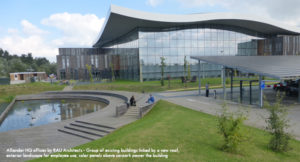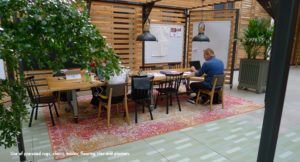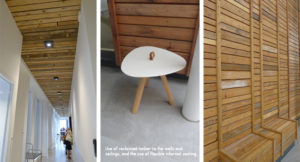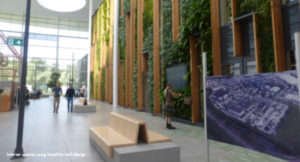Circular Economy Materials for Low Carbon, Healthy Buildings

Introduction:
In September 2019, Zero Waste Scotland in collaboration with The Alliance of Sustainable Building Products and Architecture and Design Scotland hosted the event ‘Circular Economy Materials for Low Carbon Healthy Buildings’ at The Lighthouse in Glasgow. The free daylong event focussed on discussions relating to natural and recycled materials and how they can support a circular economy.
Clive Bowman, Construction Project Manager for Zero Waste Scotland. Through my current and previous roles as a Chartered Landscape Architect, a contractor and a spatial policy researcher, I have had a long-term interest in how we can create a sustainable built environment fit for current and future communities. The answer for me lies with the guiding principles of a circular economy.
Taking these principles and applying them to the built environment, they need to be applied at both a strategic planning and a detailed design level to ensure that all future developments are resource-efficient across all aspects of the sector. When we talk about resource efficiency it is easy to get stuck on the subject of waste and recycling, but a true holistic circular economy approach is much more.
Circular Economy Approach:
The journey to a circular utopia starts with design. For example, a new housing development should be located, laid out and designed to use a minimum amount of resources. The component products and construction materials need to be high quality, come from a renewable source, be carbon neutral or positive and be healthy to the whole ecosystem. They also need to be easily recovered and have the ability to be reused again and again and again.
A circular economy built environment also ensures that the people occupying those buildings will use fewer resources throughout their lives. If their homes are energy-efficient, located close to work/education and promotes a high level of wellbeing, occupiers of those buildings will use less energy, infrastructure and health care resources, and are likely to be more productive.
Event:
This was the theme of the free seminar ‘Circular Economy Materials for Low Carbon, Healthy Buildings’, held at The Lighthouse, Glasgow on the 19th September 2019. It was an event jointly organised by Zero Waste Scotland, The Alliance for Sustainable Building Products and Architecture and Design Scotland. Presentations covered circular economy design principles using circular construction materials and the associated health benefits of natural/bio-based circular economy materials. These inspiring talks, together with a visit to the Architecture and Design Scotland’s Library of Sustainable Building Materials and a speed dating session with product manufacturers made it a very successful event.
Biophilic Design:
Elina Grigoriou from Grigoriou Interiors presentation made me think more about the impact that a good or bad construction material can have on our mental health. Elina highlighted some studies showing that selecting natural materials has been proven to have a direct impact on people’s sense of wellbeing and can reduce stress. This was further reinforced by a great presentation on biophilic design by Joe Clancy of WSP, Edinburgh. Biophilic design used in architecture can connect building and external space occupants more closely to nature. It incorporates the use of natural lighting and ventilation, natural landscape materials (including plants), colours, shapes and patterns to create a more productive and healthier built environment for people.
Carbon Emissions:
The environmental agenda is currently dominated by a drive to reduce carbon emissions from transport and energy use. When we look deeper into the opportunities that the built environment has to reduce carbon, much of the potential gains are related to embodied carbon emissions. The secondary effects of where, how and what we build our buildings with have carbon implications across the whole of society.
The Netherlands:
Just before this event in mid-September, I spent six days in the Netherlands on a busman’s holiday. I dragged my wife on a cycling tour of as many examples of circular economy buildings as I could find. It was truly inspiring.
In October 2016, A Circular Economy in the Netherlands by 2050 was launched. This programme is a nationwide plan drawn up by multiple departments to function as a vision for the successful implementation of the circular economy. The goal formulated in this report is to reduce the number of primary resources used in the Netherlands by 50% by 2030 and to become completely circular by 2050.
Like Scotland, construction is a priority sector to the Dutch economy and that has a big impact on the environment. However, in many ways, The Netherlands just seem to be that little bit further ahead on the road to a circular economy.
Alliander HQ Offices in Duiven – RAU Architects:
This project incorporated many of the principles of good circular economy design. First of all, instead of demolishing the existing 1980s buildings on site, it reused them by linking them with a new roof and glazed walls. The creativity and vision of the designers and clients are inspiring. The existing buildings were then clad in reclaimed timber. Biophilic design was brought into the new enclosed glazed space, with luscious green walls creating a light, comfortable working area. Much of the detailing looked like it was also easy to deconstruct for material reuse. The exterior provided garden areas for employees and solar panel roofed bicycle and car parking areas supplied energy to the building making it operationally carbon positive.
Future events:
The event on the 19thof September 2019 was just one in a programme of Zero Waste Scotland events linked to circular economy construction throughout 2019 and 2020. Keep an eye on Eventbrite for future free events. Zero Waste Scotland is also offering free specialist support to businesses on circular design, circular procurement and use of BIM and other digital technologies.
For more information on events, specialist support or my trip to the Netherlands and the buildings I saw, please contact me on clive.bowman@zerowastescotland.org.uk.
Clive Bowman, Construction Project Manager for Zero Waste Scotland.













